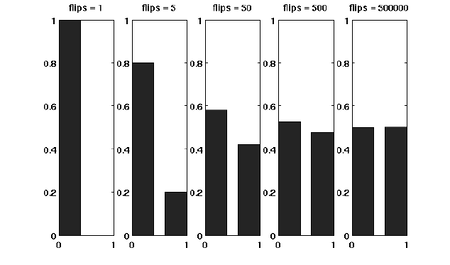随机算法 (Spring 2013)/Threshold and Concentration
Erdős–Rényi Random Graphs
Consider a graph
Such graph is denoted as
Informally, the presence of every edge of
Monotone properties
A graph property is a predicate of graph which depends only on the structure of the graph.
Definition - Let
- Let
We are interested in the monotone properties, i.e., those properties that adding edges will not change a graph from having the property to not having the property.
Definition - A graph property
- A graph property
By seeing the property as a function mapping a set of edges to a numerical value in
Some examples of monotone graph properties:
- Hamiltonian;
- contains a subgraph isomorphic to some
- non-planar;
- chromatic number
- girth
From the last two properties, you can see another reason that the Erdős theorem is unintuitive.
Some examples of non-monotone graph properties:
- Eulerian;
- contains an induced subgraph isomorphic to some
For all monotone graph properties, we have the following theorem.
Theorem - Let
- Let
Although the statement in the theorem looks very natural, it is difficult to evaluate the probability that a random graph has some property. However, the theorem can be very easily proved by using the idea of coupling, a proof technique in probability theory which compare two unrelated random variables by forcing them to be related.
Proof. For any
It is obvious that
Since
Threshold phenomenon
One of the most fascinating phenomenon of random graphs is that for so many natural graph properties, the random graph
A monotone graph property
- when
- when
The classic method for proving the threshold is the so-called second moment method (Chebyshev's inequality).
Threshold for 4-clique
Theorem - The threshold for a random graph
- The threshold for a random graph
We formulate the problem as such.
For any
Let
It is sufficient to prove the following lemma.
Lemma - If
- If
- If
Proof. The first claim is proved by the first moment (expectation and Markov's inequality) and the second claim is proved by the second moment method (Chebyshev's inequality).
Every 4-clique has 6 edges, thus for any
By the linearity of expectation,
Applying Markov's inequality
The first claim is proved.
To prove the second claim, it is equivalent to show that
where the variance is computed as
For any
We now compute the covariances. For any
- Case.1:
- Case.2:
- since there are 11 edges in the union of two 4-cliques that share a common edge. The contribution of these pairs is
- Case.2:
- since there are 9 edges in the union of two 4-cliques that share a triangle. The contribution of these pairs is
Putting all these together,
And
which is
Threshold for balanced subgraphs
The above theorem can be generalized to any "balanced" subgraphs.
Definition - The density of a graph
- A graph
- The density of a graph
Cliques are balanced, because
Theorem (Erdős–Rényi 1960) - Let
- Let
Sketch of proof. For any
Note that
By Markov's inequality,
By Chebyshev's inequality,
The first term
For the covariances,
Therefore, when
Chernoff Bound
Suppose that we have a fair coin. If we toss it once, then the outcome is completely unpredictable. But if we toss it, say for 1000 times, then the number of HEADs is very likely to be around 500. This striking phenomenon, illustrated in the right figure, is called the concentration. The Chernoff bound captures the concentration of independent trials.

The Chernoff bound is also a tail bound for the sum of independent random variables which may give us exponentially sharp bounds.
Before proving the Chernoff bound, we should talk about the moment generating functions.
Moment generating functions
The more we know about the moments of a random variable
Definition - The moment generating function of a random variable
- The moment generating function of a random variable
By Taylor's expansion and the linearity of expectations,
The moment generating function
The Chernoff bound
The Chernoff bounds are exponentially sharp tail inequalities for the sum of independent trials.
The bounds are obtained by applying Markov's inequality to the moment generating function of the sum of independent trials, with some appropriate choice of the parameter
Chernoff bound (the upper tail) - Let
- Then for any
- Let
Proof. For any where the last step follows by Markov's inequality.
Computing the moment generating function
Let
We bound the moment generating function for each individual
where in the last step we apply the Taylor's expansion so that
Therefore,
Thus, we have shown that for any
For any
The idea of the proof is actually quite clear: we apply Markov's inequality to
We then proceed to the lower tail, the probability that the random variable deviates below the mean value:
Chernoff bound (the lower tail) - Let
- Then for any
- Let
Proof. For any For any
Some useful special forms of the bounds can be derived directly from the above general forms of the bounds. We now know better why we say that the bounds are exponentially sharp.
Useful forms of the Chernoff bound - Let
- 1. for
- 2. for
- Let
Proof. To obtain the bounds in (1), we need to show that for To obtain the bound in (2), let
Balls into bins, revisited
Throwing
Now we give a more "advanced" analysis by using Chernoff bounds.
For any
Let
Then the expected load of bin
For the case
Note that
When
When
Let
Thus,
Applying the union bound, the probability that there exists a bin with load
Therefore, for
For larger
When
We can apply an easier form of the Chernoff bounds,
By the union bound, the probability that there exists a bin with load
Therefore, for